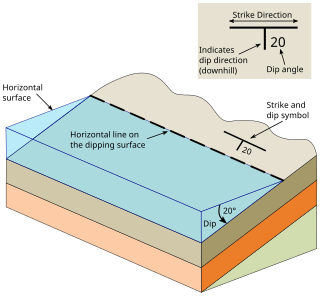
In mathematics, the slope or gradient of a line is a number that describes the direction of the line on a plane. Often denoted by the letter m, slope is calculated as the ratio of the vertical change to the horizontal change between two distinct points on the line, giving the same number for any choice of points.

In photography, angle of view (AOV) describes the angular extent of a given scene that is imaged by a camera. It is used interchangeably with the more general term field of view.

A proscenium is the metaphorical vertical plane of space in a theatre, usually surrounded on the top and sides by a physical proscenium arch and on the bottom by the stage floor itself, which serves as the frame into which the audience observes from a more or less unified angle the events taking place upon the stage during a theatrical performance. The concept of the fourth wall of the theatre stage space that faces the audience is essentially the same.

The grade (US) or gradient (UK) of a physical feature, landform or constructed line refers to the tangent of the angle of that surface to the horizontal. It is a special case of the slope, where zero indicates horizontality. A larger number indicates higher or steeper degree of "tilt". Often slope is calculated as a ratio of "rise" to "run", or as a fraction in which run is the horizontal distance and rise is the vertical distance.

The angle of repose, or critical angle of repose, of a granular material is the steepest angle of descent or dip relative to the horizontal plane on which the material can be piled without slumping. At this angle, the material on the slope face is on the verge of sliding. The angle of repose can range from 0° to 90°. The morphology of the material affects the angle of repose; smooth, rounded sand grains cannot be piled as steeply as can rough, interlocking sands. The angle of repose can also be affected by additions of solvents. If a small amount of water is able to bridge the gaps between particles, electrostatic attraction of the water to mineral surfaces increases the angle of repose, and related quantities such as the soil strength.

A spotlight is a powerful stage lighting instrument which projects a bright beam of light onto a performance space. Spotlights are controlled by a spotlight operator who tracks actors around the stage. Spotlights are most commonly used in concerts, musicals and large-scale presentations in which highlighting a specific mobile individual is critical. Spotlights are sometimes located overhead on catwalks. In some theatres, they may also be located in the control booth or purpose-built "spot booths" in addition to the catwalk.

In theatre, blocking is the precise staging of actors to facilitate the performance of a play, ballet, film or opera. Historically, the expectations of staging/blocking have changed substantially over time in Western theater. Prior to the movements toward "realism" that occurred in the 19th century, most staging used a "tableau" approach, in which a stage picture was established whenever characters entered or left the stage, ensuring that leading performers were always shown to their best advantage. In more recent times, while nothing has changed about showing leading performers to their best advantage, there have been changing cultural expectations that have made blocking/staging more complicated.

In theatre and performing arts, the stage is a designated space for the performance of productions. The stage serves as a space for actors or performers and a focal point for the audience. As an architectural feature, the stage may consist of a platform or series of platforms. In some cases, these may be temporary or adjustable but in theaters and other buildings devoted to such productions, the stage is often a permanent feature.

A theater, or playhouse, is a structure where theatrical works, performing arts, and musical concerts are presented. The theater building serves to define the performance and audience spaces. The facility usually is organized to provide support areas for performers, the technical crew and the audience members, as well as the stage where the performance takes place.

A fly system, or theatrical rigging system, is a system of ropes, pulleys, counterweights and related devices within a theater that enables a stage crew to fly (hoist) quickly, quietly and safely components such as curtains, lights, scenery, stage effects and, sometimes, people. Systems are typically designed to fly components between clear view of the audience and out of view, into the large space, the fly loft, above the stage.
This article contains a list of cinematic techniques that are divided into categories and briefly described.

In geology, strike and dip is a measurement convention used to describe the plane orientation or attitude of a planar geologic feature. A feature's strike is the azimuth of an imagined horizontal line across the plane, and its dip is the angle of inclination measured downward from horizontal. They are used together to measure and document a structure's characteristics for study or for use on a geologic map. A feature's orientation can also be represented by dip and dip direction, using the azimuth of the dip rather than the strike value. Linear features are similarly measured with trend and plunge, where "trend" is analogous to dip direction and "plunge" is the dip angle.

Theater drapes and stage curtains are large pieces of cloth that are designed to mask backstage areas of a theater from spectators. They are designed for a variety of specific purposes, moving in different ways and constructed from various fabrics. Many are made from black or other darkly colored, light-absorbing material. Theater drapes represent a portion of any production's soft goods, a category comprising any non-wardrobe, cloth-based element of the stage or scenery. Theater curtains are often pocketed at the bottom to hold weighty chain or to accept pipes to remove their fullness and stretch them tight.
Rake describes the angle made by a sloped surface with respect to a horizontal or vertical reference. The usages of this term include:

Bicycle and motorcycle geometry is the collection of key measurements that define a particular bike configuration. Primary among these are wheelbase, steering axis angle, fork offset, and trail. These parameters have a major influence on how a bike handles.
There are different types of theatres, but they all have three major parts in common. Theatres are divided into two main sections, the house and the stage; there is also a backstage area in many theatres. The house is the seating area for guests watching a performance and the stage is where the actual performance is given. The backstage area is usually restricted to people who are producing or in the performance.

The Cockpit Theatre is a fringe theatre in Marylebone, London. Designed by Edward Mendelsohn and built in 1969–70 by the Inner London Education Authority (ILEA) as a community theatre, it is London's first purpose-built Theatre in the round since the Great Fire of London. When ILEA was disbanded in 1990, ownership of the Cockpit was transferred to the London Borough of Westminster, who made it part of the newly renamed City of Westminster College. It remains one of a handful of purpose-built theatre training venues in the capital.

Stage machinery, also known as stage mechanics, comprises the mechanical devices used to create special effects in theatrical productions, including scene changes, lowering actors through the stage floor (traps) and enabling actors to 'fly' over the stage.
In architecture, sightlines are a particularly important consideration in the design of civic structures, such as a stage, arena, or monument. They determine the configuration of such items as theater and stadium design, road junction layout and urban planning. In cities such as London, construction within sightlines is restricted to protect the key views of famous landmarks

















